Wind Turbine Layout / Array
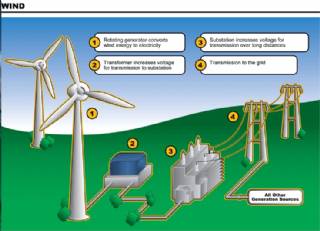
In a wind farm,turbines can be arranged in many different layouts. The layout should relate to the specific characteristics of the landscape -this means that the most suitable layout for every development will be different. The development process typically begins with a layout that responds mainly to wind speed and wind turbine specification, sited within defined land ownership / tenure boundaries. For a small wind farm, this might comprise a single row of wind turbines along a ridge; while, for a larger development, a grid of wind turbines is often taken as the starting point, with the turbines spaced at minimum separation distances to avoid turbulence.
From this starting point turbines will be moved or removed due to physical constraints, such as watercourses, areas of deep peat and steep slopes, and in response to sensitive habitat or wildlife species. During this process of modification, landscape and visual issues will also inform the layout. Although some landscape and visual concerns –such as the need to avoid visibility from a particularly sensitive viewpoint -may present an absolute constraint, many landscape and visual sensitivities can be addressed through good design. This commonly involves a number of changes to create the most appropriate wind farm.
There are several common types of layout divided into regular or irregular formats. Generally, the fewer turbines and the simpler the layout on an even landform, the easier it is to create a positive feature -visually balanced, simple and consistent in image as it is viewed from various directions. This is most easily achieved by a simple line upon level ground. As soon as there is deviation from this, the design becomes more complicated.
A regular shape, such as a double line, a triangle, or a grid can appear appropriate within a wide open and level space where there is a regular landscape pattern, such as within agricultural fields. However,as you move through the landscape and see it from different directions and elevations, views of the grid change and reveal a variable effect, seemingly ordered along some rows, but in others overlapping. In addition, the rationale of the position of turbines appears confused if they are at different elevations.
Irregular layouts can be more appropriate in landscapes of variable elevation and pattern. However, irregular forms pose a greater challenge in terms of achieving a simple image,as the turbines will interact in varying ways with each other as well as with the underlying landscape. This can result in negative effects such as unevenvisual densities of wind turbines, overlapping turbine rotors (often termed ‘stacking’), partial screening behind a skyline and turbine outliers separate from the main group.
Wind farms should relate to underlying landscape characteristics of a similar scale and/or prominence. Wind turbines can be accommodated in areas of complex pattern, provided that their siting and design does not dominate the elements whichdefine this. Odd numbers of turbines often present a more balanced composition than even numbers.
The design of offshore wind farms, with the greatest number of turbines in formal grid layouts, can lead to distinctive visual effects. From one part of the coast offshore turbines will be seen clearly in rows with the sea horizon visible between them, but by moving along the coast the design can appear more confused,with the turbines appearing as a constant mass on the horizon. It will be important to consider these design effects during project development and appraise the wind farm’s image from sensitive receptors.
Labels
renewable energy wind energyWind Turbine Layout / Arraywind turbine controlwind energy turbineturbine wind energywind turbine plans freeFarming Principle: Deep Soil Preparation
Looking at GB as a three-legged stool, deep soil preparation is one of the legs. Deep soil preparation builds soil and soil structure by loosening the soil to a depth of 24 inches (60 cm). Ideal soil structure has both pore space for air and water to move freely and soil particles that hold together nicely.

Smart Home Ecosystem - Smart Home Automation - Smart Home Security - Smart Home Technology
The outer-most level corresponds to the individual devices and sensors that consumers interact with. Several candidates are vying for the role of a leader introducing smart home services to the mass market.

Solar Energy Systems - Solar Modules - Solar Electric System Design - Solar Power
The heart of a photovoltaic system is the solar module. Many photovoltaic cells are wired together by the manufacturer to produce a solar module. When installed at a site, solar modules are wired together in series to form strings. Strings of modules are connected in parallel to form an array.
Solar Energy Systems - Array Mounting Racks - Solar Ray - Solar Panel - PV Racks and Mounts
Arrays are most commonly mounted on roofs or on steel poles set in concrete. In certain applications, they may be mounted at ground level or on building walls. Solar modules can also be mounted to serve as part or all of a shade structure such as a patio cover. On roof-mounted systems, the PV array is typically mounted on fixed racks, parallel to t

Solar Energy Systems - Grounding Equipment
Grounding equipment provides a well-defined, low-resistance path from your system to the ground to protect your system from current surges from lightning strikes or equipment malfunctions. Grounding also stabilizes voltages and provides a common reference point. The grounding harness is usually located on the roof.
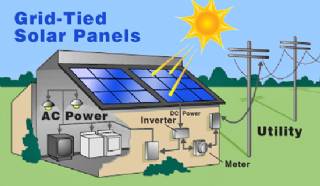
Solar Energy Systems - Solar Inverter - Solar Panel Inverter
Most grid-connected inverters can be installed outdoors, while most off-grid inverters are not weatherproof. There are essentially two types of grid-interactive inverters: those designed for use with batteries and those designed for a system without batteries.
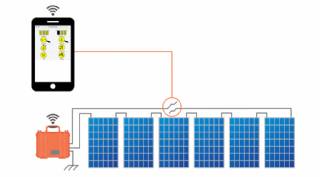
Solar Energy Systems - Solar Disconnects
Automatic and manual safety disconnects protect the wiring and components from power surges and other equipment malfunctions. They also ensure the system can be safely shut down and system components can be removed for maintenance and repair.
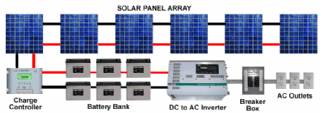
Solar Energy Systems - Solar Battery Bank
Batteries store direct current electrical energy for later use. This energy storage comes at a cost, however, since batteries reduce the efficiency and output of the PV system, typically by about 10 percent for lead-acid batteries. Batteries also increase the complexity and cost of the system.

Solar Energy Systems - Solar Charge Controller
A charge controller, sometimes referred to as a photovoltaic controller or battery charger, is only necessary in systems with battery back-up. The primary function of a charge controller is to prevent overcharging of the batteries. Most also include a lowvoltage disconnect that prevents over-discharging batteries. In addition, charge controllers pr
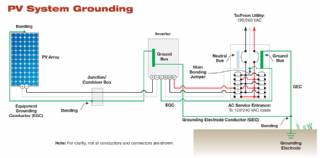
Solar Energy Systems - The NEC and PV Systems
Solar PV systems must be installed in accordance with Article 690 of the National Electric Code, which specifically deals with PV systems, as well as several other articles of the NEC that pertain to electrical systems in general. When there is a conflict between NEC 690 and any other article, NEC 690 takes precedence due to the unique nature of PV